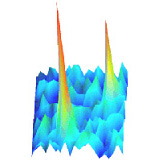 A multitude of signal transduction cascades are initiated by interactions between proteins at the plasma membrane resulting in complex cellular responses. To fully understand the different steps in signal transduction processes it is important to study the initial steps of the signaling cascade. We focus on the development of a single-molecule microscopy technique to study processes at the level of individual proteins and identifying the most suited markers for single-molecule in vivo experiments.
A multitude of signal transduction cascades are initiated by interactions between proteins at the plasma membrane resulting in complex cellular responses. To fully understand the different steps in signal transduction processes it is important to study the initial steps of the signaling cascade. We focus on the development of a single-molecule microscopy technique to study processes at the level of individual proteins and identifying the most suited markers for single-molecule in vivo experiments.
The dynamic organization of proteins and lipids in the plasma membrane of cells play a vital role in numerous biological processes. Many proteins involved in the initial steps of cell signaling like G-protein coupled receptors (GPCRs), G-proteins, and the small GTPase Ras are attached or recruited to the membrane via lipid molecules. Plasma membrane localization of the signaling proteins is crucial for their function as is the local structure of the membrane itself.
The plasma membrane contains domains with specific sets of proteins and lipids, such as detergent-resistant domains, caveolae, and rafts. Those domains could function as dynamic signaling depots, where GPCRs, G-proteins, Ras, and others are clustered. The distribution of receptors into such compartments will control their accessibility to ligands and signaling molecules like G-proteins, and is probably an important regulatory mechanism. Although such domains – frequently called rafts – have been inferred from functional and kinetic studies of intact cells, most evidence of their existence is based on differential extraction of cells with detergent. The relationship between membrane extracts and the in vivo composition and structure of lipid rafts is uncertain and controversial, also because of the lack of sensitive techniques to investigate the interaction between individual molecules.
We use and further develop in vivo single-molecule microscopy to follow in real-time the dynamic reorganization of the plasma membrane on cellular stimulation. We concentrate on the first few steps of signal transduction pathways, the recognition of a ligand (e.g. fluorescent labeled cAMP, LPS and SDF-1) by a receptor fused to GFP (adenosine receptor, cAMP receptor, CXCR4 chemokine receptor, TOLL-like receptor, interferon receptor) in vivo. Correlation with simultaneous observation of other GFP-fused membrane proteins (G-proteins, Ras, CD14, MyD88, PH-domain containing proteins) allows us to obtain information on the dynamics of receptor distribution, ligand-receptor interactions, homo- and hetero-oligomerization of the receptors, and the membrane organization in a living cell.
in collaboration with:
Herman Spaink, Marcel Schaaf & Ewa Snaar-Jagalska, Department of Cell Biology
Bram Koster, Leiden University Medical Center
latest results:
Role of the lipid anchor: P.H.M. Lommerse, K. Vastenhoud, N.J. Pirinen, A.I. Magee, H.P. Spaink & T. Schmidt. “Single-molecule diffusion reveals similar mobility for the Lck, H-ras, and K-ras membrane anchors.”, Biophys J. (2006) 91:1090.
Functional nano-domains: P.H.M. Lommerse, B.E. Snaar-Jagalska, H.P. Spaink & T. Schmidt. “Single-Molecule Diffusion Measurements of H_Ras at the Plasma Membrane of Live Cells Reveal Microdomain Localization Upon Activation”, J.Cell Sci. (2005) 118:1799.

